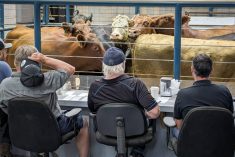Western Canadian feeder cattle prices were $2-$3 per hundredweight lower last week. Fed cattle prices came under pressure and barley prices surged higher, resulting in a negative tone for the feeder market.
In central Alberta, mixed feeder steers averaging 584 pounds brought back $186/cwt, which was considered high compared to other auction barns. Angus-cross medium flesh steers weighing 750 to 800 lbs. averaged $155 in southern Alberta. The market felt soft, especially on replacement cattle over 750 pounds.
Warm temperatures across the Prairies have tempered demand for grass cattle. Reports of grass fires in parts of southern Alberta and Saskatchewan have caused buyers to step to the sidelines. It is only March but a large portion of Western Canada has received less than 50 per cent of normal precipitation over the past 90 days and if conditions don’t change, forage supplies could get tight later in summer. Above-average temperatures and below-normal rainfall do not bode well for the feeder market.
Read Also

Huge crops in South America says analyst
Although there’s a debate over the size of the South American soybean crop, there’s little doubt that it will be an enormous one, said consultant Michael Cordonnier of Soybean and Corn Advisor in Hinsdale, Ill.
Cash barley prices reached up to $230 on Wednesday in Feedlot Alley of southern Alberta, approximately $20 higher than a month ago. This barley rally is not over now that road bans are in place in most regions. Feedlots need a break-even price of $121/cwt in June for fed cattle and with the market only at $113/cwt, losses could rack up over $100 per head given the current environment.
Wholesale beef prices have come off their highs, causing packing margins to remain in negative territory. Larger supplies of pork and poultry have cause the price-conscious consumer to switch from beef to other protein sources. U.S. average consumer disposable income is only up only three per cent from last year, while ground beef prices are up 20 per cent. The market is rationing demand due to the income constraint.
— Jerry Klassen is a commodity market analyst in Winnipeg and maintains an interest in the family feedlot in southern Alberta. He writes an in-depth biweekly commentary, Canadian Feedlot and Cattle Market Analysis, for feedlot operators in Canada. He can be reached by email at [email protected] or at 204-287-8268 for questions or comments.














